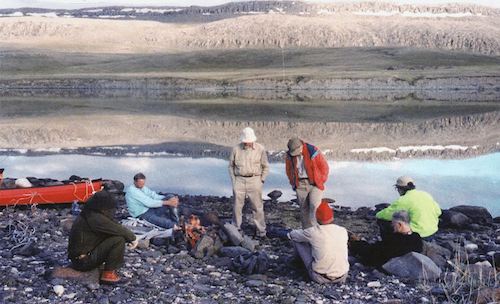A Yankee Notebook
NUMBER 2204
October 15, 2023
Old Voyageurs
EAST MONTPELIER, VT – It’s for years irritated me that my fellow countrymen know so little about their next-door neighbor to the north. When my friends and I in the Geriatric Adventure Society first began traveling to the Arctic for our biennial canoe trips on the so-called Barren Lands, we often heard, “Arctic, eh? Whereabouts in Alaska?”
Well, actually, nowhereabouts. If you look at a map of North America, you really can’t help but notice that the North American Arctic stretches all the way across the United States, from well east if Eastport, Maine, to west of Seattle. It’s called Canada. Our relatively tiny bit of the Arctic is an obvious appendage tacked onto the western border of Yukon. We bought it from Russia in 1867, for two cents an acre, over the objections of the general public, who at the time called it “Seward’s Folly” or “Seward’s Icebox,” after the American Secretary of State William Seward. It has some lovely rivers, but none to compare in beauty or number to Arctic Canada. Not to mention that it’s a very long way from New England. Thus, for us, it’s always been Canada that’s satisfied our thirst for adventure and filled our logbooks with memories.
What’s gotten me going on this is an evening I spent this past weekend with a group of outdoor enthusiasts who’ve paddled northern rivers and traveled on snowshoes and skis when the lakes and rivers have been frozen. Except for a higher-than-usual number of beards, you’d never pick them out of a crowd, but they’ve been places and seen things that other people in that crowd have only read about.
One little story that’s stuck with me is of a winter snowshoe trip from the headwaters of the George River in Ungava all the way down to its mouth at Kangiqsualujjuaq. When its leader showed the proposed route to a local Inuk, the elder said simply, “Hmm. Long trip. Maybe you die.” They didn’t die, but you can easily imagine the excitement of snowshoeing, while pulling a heavy pulk, over ice invigorated by 30-foot tides.
Some of us in the room have paddled the Leaf River, which runs nearly the entire width of the Ungava Peninsula (like the Amazon in South America). We’ll never forget the weird sensation of handling 17-foot canoes in 15-meter tides. That’s larger than the famous Bay of Fundy tides, but it gets no official press because the Bay of Fundy is a lucrative tourist attraction, while Leaf Bay is much farther north and has no accommodations to speak of (we slept on the school gym floor in Tasiujaq).
A couple of the attendees have paddled the wild Korok River, which rises in the incredibly tortured Torngat Mountains on the east coast of Labrador. They’re so barren and shattered by frost and glaciation that Jacques Cartier, who cruised the coast in 1534, called them “The Land God Gave to Cain.” On the Koroc, my friends were a long way from help, but a medical emergency necessitated a helicopter rescue.
Others have descended the Coppermine River in the footsteps (as it were) of John Franklin, who explored it in 1821 and named the various rapids. Poor John (later Sir John) ended his career by losing both his ships and all the crew – including himself – in an attempt to navigate the Northwest Passage. He ended the earlier trip losing about half his men hiking across the Barrens in early winter and famously “eating his shoes.” We did not, and instead stayed with a good friend and his wife at his lovely home at the river mouth.
The men and women at the gathering, many of them long past their voyageur days, stood about in little klatsches comparing experiences and swapping information, just in case. There were a few faces famous in the paddling community for the trips they’d done, and others famous for trips they’re still doing. Several of us old-timers, crippled by arthritis, miss keenly our active days, but take some comfort in the memories we’ve created and the color slides we have to show to buttress them. The day of the slide show is pretty much past, by the way; nowadays canoeists either mount or wear a GoPro, which makes a far livelier show than a still camera.
Many of the attendees camped out for the weekend. The big lawn was dotted with tents, from one-person popups to a huge white canvas wall tent with a long stovepipe sticking out through a metal flange. In a nod to our outdoor spirits, our cabins weren’t heated. It was a cold night both outdoors and in. How pleasant it was once again to slide into my old down-filled bag and dream of Arctic nights.


